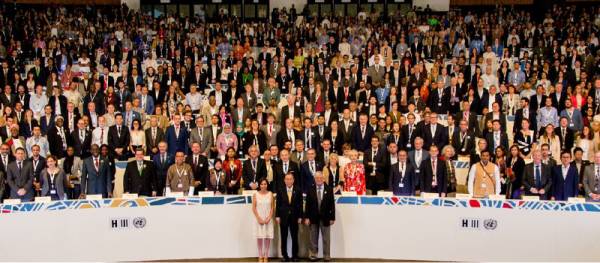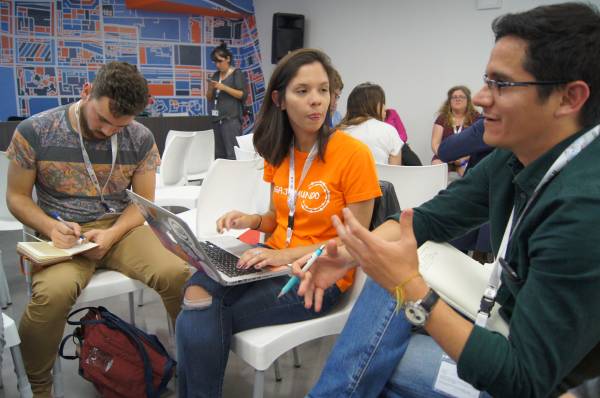Habitat III, the United Nations Conference on Housing and Sustainable Urban Development conference concluded in Quito with yet another global agreement — the New Urban Agenda.

Official photo from UN-Habitat III.
Several parallel spaces emerged to challenge the narrative of Habitat III and point out the contradictions between the objectives that the United Nations were putting on paper on one hand and the institutional action seen at the local level on the other. A truly global issue, considering that more than half of the world’s population already live in urban areas.
In a way, the conference space served as a model for some of the challenges our cities face: inequality and an unjust distribution of resources, a growing demand for services, and poor planning and management.
The host country opened the registration in the prior weeks for anybody interested in attending. Over 16,000 Ecuadorians and 10,000 international participants signed up (media reported up to 50,000 people including participants in parallel events), and getting inside the venue became a nightmare.
Though the vision of the conference was to discuss creating ‘cities for all’, the accredited country delegates and speakers were granted the privilege of a smooth, quick access. For everyone else, getting inside the Habitat III venue meant standing for at least a couple of hours in line experiencing the moody Quito weather, which could quickly shift from pleasantly sunny to a persistent drizzle.
Discussions between civil society organizations, indigenous representatives, youth movements, grassroots groups and scholars, at events inside and outside of Habitat III, revolved around the need to bring the global issues raised in the New Urban Agenda to terms of real significance for many different groups, particularly those facing some form of marginalization or discrimination.

Young activists exchanged learnings during a side event on strengthening urban movements.
Those taking action to reclaim people’s right to the city need to break a vicious cycle marked by the lack of information people have about their own rights, the lack of space in the public spheres to reclaim it, and the overall lack of hope that things can change — a context which may sound all too familiar to those in the climate movement. Building livable cities, instead of black holes in which people are sucked into a production dynamic that ends up preventing them from actually enjoying their lives and surroundings, requires the engagement of everybody.
Urban activism has taught social leaders speaking in Quito that the only way to reclaim public space is by actually taking it over. Probably the clearest take-away from all these conversations is the interconnection between social movements, and how the achievement of our movement goals will only be possible through people taking action. Cities should be designed and built to meet human needs, to create happy, livable and safe spaces for everyone. And it is up to activists and organizers to empower all the different groups to take part in reclaiming these rights.

At a busy intersection in Quito, Peatón Man (Ecuador), Super Ando (Brazil), and Peatónito (Mexico), fight for the right of pedestrians to reach their destination safely.
The first Habitat urban agenda was signed in Vancouver in 1976 and was reviewed twenty years later for Habitat II. Its original promise, “creating more livable, attractive and efficient settlements which recognize human scale, the heritage and culture of people and the special needs of disadvantaged groups ”, remains unfulfilled.
The New Urban Agenda is a non-binding agreement for the signatory countries, but it resonates with other international frameworks, like the Sustainable Development Goals (Goal 11 is making cities and human settlements inclusive, safe, resilient and sustainable) and the UNFCCC climate negotiations. Although they cover less than 2 per cent of the earth’s surface, cities consume 78 per cent of the world’s energy and produce more than 60% of all CO2 and other greenhouse gas emissions. At the same time, hundreds of millions of people in urban areas across the world are vulnerable to rising sea levels, increased precipitation, inland floods, more frequent and stronger cyclones and storms, and periods of more extreme heat and cold. Strong voices from participants involved in the climate negotiations demanded concrete terms for implementing New Urban Agenda. Many experts have recommended that the implementation and follow-up of all these global sustainability agendas should actually be linked together.
Ultimately, achieving the goals of a New Urban Agenda is conditional to achieving what is stated in the Sustainable Development Goals and the Paris Agreement. Hopefully, UNFCCC negotiators will put the same energy with which they demanded action from Habitat III, in setting the steps to advance towards the goals of the Paris Agreement in the imminent COP22, starting in a few weeks in Marrakech. To follow the action at COP22 sign up here.